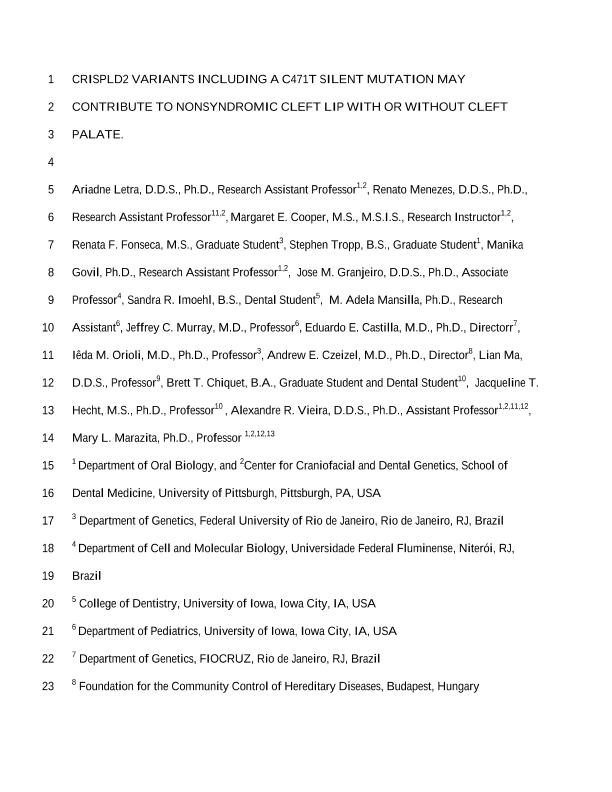Artículo
CRISPLD2 variants including a C471T silent mutation may contribute to nonsyndromic cleft lip with or without cleft palate
Letra, Ariadne; Menezes, Renato; Cooper, Margaret E.; Fonseca, Renata F.; Tropp, Stephen; Govil, Manika; Granjeiro, Jose M.; Imoehl, Sandra R.; Mansilla, M. Adela; Murray, Jeffrey C.; Castilla, Eduardo Enrique ; Orioli, Ieda Maria; Czeizel, Andrew E.; Ma, Lian; Chiquet, Brett T.; Hecht, Jacqueline T.; Vieira, Alexandre R.; Marazita, Mary L.
; Orioli, Ieda Maria; Czeizel, Andrew E.; Ma, Lian; Chiquet, Brett T.; Hecht, Jacqueline T.; Vieira, Alexandre R.; Marazita, Mary L.
 ; Orioli, Ieda Maria; Czeizel, Andrew E.; Ma, Lian; Chiquet, Brett T.; Hecht, Jacqueline T.; Vieira, Alexandre R.; Marazita, Mary L.
; Orioli, Ieda Maria; Czeizel, Andrew E.; Ma, Lian; Chiquet, Brett T.; Hecht, Jacqueline T.; Vieira, Alexandre R.; Marazita, Mary L.
Fecha de publicación:
08/2010
Editorial:
Alliance Communications Group Division Allen Press
Revista:
Cleft Palate-Craniofacial Journal
ISSN:
1055-6656
Idioma:
Inglés
Tipo de recurso:
Artículo publicado
Clasificación temática:
Resumen
Objective: To assess the association between nonsyndromic (NS) cleft lip with or without cleft palate (CL(P)) and single-nucleotide polymorphisms (SNPs) within the CRISPLD2 gene (cysteine-rich secretory protein LCCL domain containing 2). Design: Four SNPs within the CRISPLD2 gene domain (rs1546124, rs8061351, rs2326398, rs4783099) were genotyped to test for association via family-based association methods. Participants: A total of 5826 individuals from 1331 families in which one or more family member is affected with CL(P). Results: Evidence of association was seen for SNP rs1546124 in U.S. (p = .02) and Brazilian (p = .04) Caucasian cohorts. We also found association of SNP rs1546124 with cleft palate alone (CP) in South Americans (Guatemala and ECLAMC) and combined Hispanics (Guatemala, ECLAMC, and Texas Hispanics; p = .03 for both comparisons) and with both cleft lip with cleft palate (CLP; p = .04) and CL(P) (p = .02) in North Americans. Strong evidence of association was found for SNP rs2326398 with CP in Asian populations (p = .003) and with CL(P) in Hispanics (p = .03) and also with bilateral CL(P) in Brazilians (p = .004). In Brazilians, SNP rs8061351 showed association with cleft subgroups incomplete CL(P) (p = .004) and unilateral incomplete CL(P) (p = .003). Prediction of SNP functionality revealed that the C allele in the C471T silent mutation (overrepresented in cases with CL(P) presents two putative exonic splicing enhancer motifs and creates a binding site AP-2 alpha, a transcription factor involved in craniofacial development. Conclusions: Our results support the hypothesis that variants in the CRISPLD2 gene may be involved in the etiology of NS CL(P).
Palabras clave:
CLEFT LIP
,
CLEFT PALATE
,
CRISPLD2 GENE
,
SUBPHENOTYPES
Archivos asociados
Licencia
Identificadores
Colecciones
Articulos(SEDE CENTRAL)
Articulos de SEDE CENTRAL
Articulos de SEDE CENTRAL
Citación
Letra, Ariadne; Menezes, Renato; Cooper, Margaret E.; Fonseca, Renata F.; Tropp, Stephen; et al.; CRISPLD2 variants including a C471T silent mutation may contribute to nonsyndromic cleft lip with or without cleft palate; Alliance Communications Group Division Allen Press; Cleft Palate-Craniofacial Journal; 48; 4; 8-2010; 363-370
Compartir
Altmétricas



